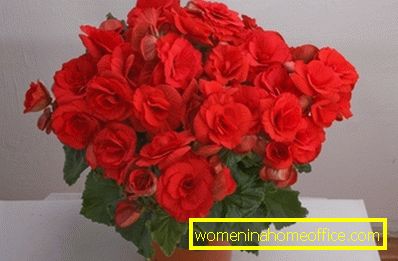Begonia
Begonia is a beautiful plant that grows well at home. She received the name in honor of her great admirer - the governor of San Domingo Michel Begon. Currently, there are about 900 species of begonias, each of which is different in color, number of inflorescences, leaf shape. The largest type of begonia grows to a height of three meters, and the smallest - a few centimeters.
Begonia care at home
Caring for begonia is very specific, because it refers to the indoor plants that bloom almost all year round. It is worth knowing that begonia absorbs harmful substances, so it will be very appropriate in the room after the repair or in the office, begonia is a kind of air filter.

- Begonia - perennial plantoriginally from the humid tropics, but despite this, she is not a fan of direct sunlight, best of all she grows in partial shade. Also, this plant does not like excessively wet soil, so you need to be careful when it is watered, it is best to do this after complete drying of the top layer of soil. Begonia stalks at home can be subject to fungal diseases.
- Begonia also likes high air humidity, it should be no lower than 60%, to maintain this air humidity during the summer period, you can spray the air around the flower, but you should try to prevent water from falling on the leaves: if water drops fall on the begonia leaves, then specks will appear on them and they will start to rot.
- Begonia reacts sharply to changes in temperature, so it is desirable to constantly maintain a stable temperature in the room with the plant. The most acceptable temperature for the successful growth of begonias at home is 20-25 C, in the cold season - not less than 15 C. In winter, putting begonia next to the battery or heater is not recommended.
- With proper care, begonia can bloom around the clock. If the begonia begins to bush, then it should be cut.

- It is best to transplant begonia in spring in March, after the irrigation rate begins to increase. It is also necessary to track the transplant process, because before flowering its roots will have to fill the entire pot. After a year, the pot for begonias should be changed to a larger one with the addition of fresh soil (it should be at least a couple of centimeters more than the previous one). In the process of transplanting you need to be very careful and ensure that the root system is not damaged. Particular attention should be paid to the leaves of this plant, they should not accumulate a lot of dust, because Begonia leaves are a source of oxygen and nutrition. To do this, simply wipe them with a dry cloth.
- Reproduce begonia can seed and cuttings. Cuttings need to be planted in the ground and cover with a can and leave them in a warm place. A month later, the sprouts are transplanted into small pots. Do not plant seedlings in large pots, as they may die in them.
- Since begonia has a fibrous type of root system, which is characterized by a huge number of thin roots, the best type of soil for it is loose with a weakly acidic medium. It is possible to use a mixture of peat, coarse sand and leafy ground as a soil for begonia, in a ratio of 2: 1: 2. You can also use ready-made mixture for begonias, adding sand to it. You should not plant begonia in clay soil, it will not take root there.
- At home, begonias need to be fertilized with minerals, but this should be done only with moist soil: if the soil is dry, the plant can get burned by the root system during the fertilization process. In winter, the plant is better not to fertilize, the best time for this procedure is a period of growth, then begonia can be fertilized once every two weeks.

- Immediately after transplantation, begonia is also better not to feed fertilizer, you should wait at least a couple of weeks. And yet - it is better to underfeed the plant with fertilizer, rather than overload it with top dressing. The same rule should be followed when choosing the concentration of fertilizers - it is better to dilute the mixture for fertilizers in order to prevent burns of the root system of begonia.
If you follow the above tips, taking care of begonias at home will not be a lot of trouble, it will grow and will delight you with its appearance!